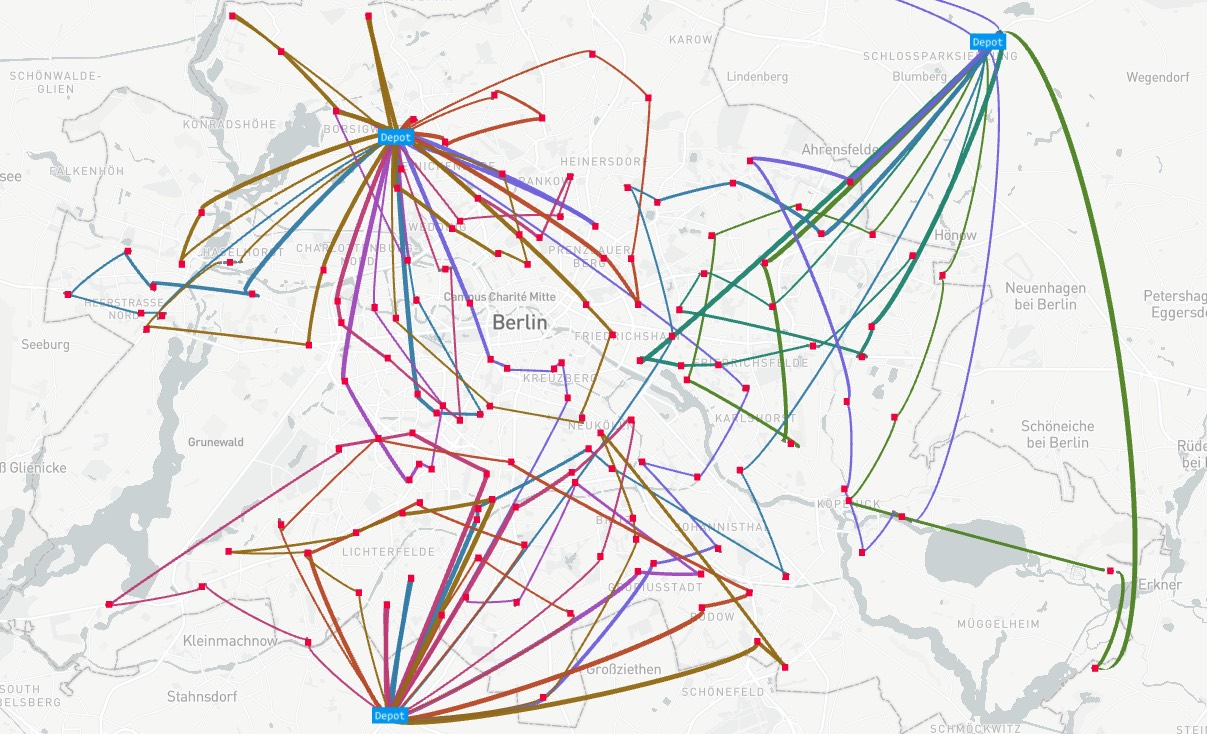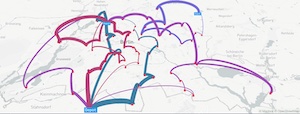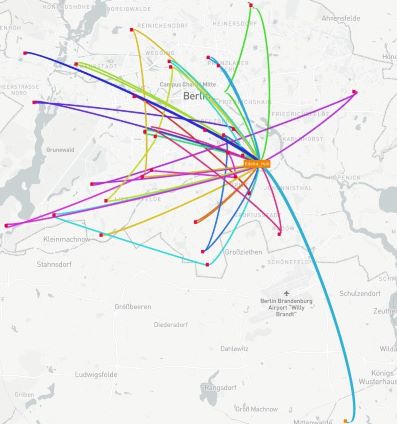 Example Tour Planning for depot-based food/grocery transport in Berlin
Example Tour Planning for depot-based food/grocery transport in Berlin
Freight research at VSP
Two projects funded by the German Research Foundation (DFG):
- Carrier Agents and Interactions with Traffic flows and
- Analysis of strategies for the full decarbonization of urban transport (ZeroCUTS),
Analyse von Strategien zur vollständigen Dekarbonisierung des urbanen Verkehrs
deal with the simulation of freight transport and the comparison of different decarbonization strategies. MATSim is coupled with the vehicle routing problem (VRP) solver Jsprit.
Solving the VRPs can be done under different conditions (e.g. vehicle types, prices, technologies), resulting in different solutions to handle the demand. By comparing the results, it is possible to show the most cost-effective solution to decarbonize the freight traffic.
The plot above depicts the results of tour planning for a food retailing chain, transporting goods from depots to the different stores in Berlin. In several studies we show that it is possible to use battery electric trucks for these tasks instead of diesel trucks.
While a few years ago their range was not sufficient for all tours, this is not an issue anymore. Moreover, the costs when using electric trucks are now comparable to using diesel trucks.
To visualize the different scenarios, including single carriers and each tour, we use the visualization tool SimWrapper, which was developed at our department.
Try the interactive tool!
VSP has developed “SimWrapper” — an interactive web-based tool for displaying and exploring MATSim simulation results.
These links work best on desktop browsers or tablets!
Simulation results are too detailed to display on a mobile phone screen.
Food retailing scenarios: freight carrier visualizations
All simulation runs for the scenario examining limited battery capacity are below.
Without Range Constraints assumes that battery capacity is not an issue for tour planning, e.g. due to recharging while loading/unloading.
With Range Constraints assumes that battery capacity limits the tour length/duration: there is no recharging possible during the tour.
| Without Range Constraints: | With Range Constraints: |
|---|---|
 No Diesel Tax |
 No Diesel Tax |
 50 € per ton CO2 |
 50 € per ton CO2 |
 150 € per ton CO2 |
 150 € per ton CO2 |
 300 € per ton CO2 |
 300 € per ton CO2 |
For both, we run multiple simulation runs with increasing variable costs per distance for the diesel trucks.
The diesel tax values came from a (fictitious) CO2 tax which increases the diesel costs. E.g. noTax, means that there is no additional tax on diesel, while Tax300 means that there is an additional tax included of 300 € per ton CO2.
Full results
To go deeper and explore every scenario available, you can click here.
There are folders for each simulation run. You can dive into the many folders of results there, categorized by battery range constraints and diesel tax costs.
Once you find a folder of results you can click the Carrier Explorer to view the interactive tool.
Have fun exploring.
Logistic Service Providers (LSPs) visualizations
In the Carrier Agents and Interactions with Traffic flows project, we are simulating logistic chains.
MATSim was extended by an agent type that makes the decision about the transport logistics process: the Logistic Service Provider (LSP). The LSP receives orders to deliver goods from a starting point to a destination. It can use various resources to fulfill the orders: The Carriers as a transport company and Hubs as transshipment points. A LSP has one or more logistics chains (consisting of carriers and optionally hubs) at its disposal. It decides in an iterative process which order is to be executed with which logistics chain. The carriers then plan their routes. This plan is evaluated and modified for the next iteration.
In the following, you can explore the simulation results for an LSPs. Again, Simwrapper is used to visualize the results.
Here, the LSP has two options for each job for delivering: a) using a direct (one-echelon) chain, or b) using a two-echelon chain with a hub in between and smaller trucks for the second echelon (last mile).

Example Usage of mix of one and two-echelon logistic chains for food/grocery transport in Berlin
Publications: for further information
Publications related to these (and many other) projects can be found here: vsp.berlin/publications
